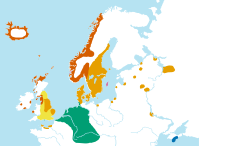History of Danish

| Part of a series on |
| Old Norse |
|---|
 |
| WikiProject Norse history and culture |
The
Runic Danish
Old East Norse is in Sweden called
A change that separated Old East Norse (Runic Swedish/Danish) from Old West Norse was the change of the diphthong æi (Old West Norse ei) to the monophthong e, as in stæin to sten. This is reflected in runic inscriptions where the older read stain and the later stin. There was also a change of au as in dauðr into ø as in døðr. This change is shown in runic inscriptions as a change from tauþr into tuþr. Moreover, the øy (Old West Norse ey) diphthong changed into ø as well, as in the Old Norse word for "island".
Middle Danish
Fangær man saar i hor seng mæth annæns mansz kunæ. oc kumær han burt liuænd....
"If one catches someone in the whore-bed with another man's wife and he comes away alive..."
Jutlandic Law, 1241 [2]
takær bondæ annær man mæth sin kunæ oc kumar swa at han dræpær anti mannen....
"If a peasant takes another man with his wife and does it happen that he does not kill the man..."
The Zealandic Law of Erik, approx. 1250[2]
hittær man annær man i siangu mæþ aþulkunu sinni ok dræpær bondæn horkarkl i sængu mæþ hænnæ....
"If one finds another man in bed with one's wedded wife and if the peasant kills the whore-churl in bed with her..."
Scanian Law, approx. 1216[2]
From 1100 and onwards, the dialect of Denmark began to diverge from that of Sweden. The innovations spread unevenly from Denmark which created a series of minor dialectal boundaries,
Renaissance and Reformation
With the
The first printed book in Danish dates from 1495, "Rimkrøniken" (the Rhyming Chronicle), a history book told in rhymed verses.[5] The first complete translation of the Bible in Danish, the Bible of Christian III, some parts translated by Christiern Pedersen, was published in 1550. Pedersen's orthographic choices set the de facto standard for subsequent writing in Danish.[6]
Modern Danish
The first translation of the Bible in Danish was published in 1550.
Some notable authors of works in Danish are
References
- ^ Jørgensen 2016, p. 82.
- ^ a b c Pedersen 1996, p. 220.
- ^ Pedersen 1996, pp. 219–21.
- ^ Pedersen 1996, pp. 221–224.
- ^ "Bog Museum (Book Museum)". Royal Danish Library. Archived from the original on 21 December 2014.
- ^ Pedersen 1996, p. 225.
- ISBN 978-0-8166-0896-6.
Bibliography
- Ejskjær, I. (1990). "Stød and pitch accents in the Danish dialects". Acta Linguistica Hafniensia. 22 (1): 49–75. .
- Gregersen, Frans; Holmen, Anne; Kristiansen, Tore; Møller, Erik; Pedersen, Inge Lise; Steensig, Jakob; Ulbæk, lb, eds. (1996). Dansk Sproglære. Dansklærerforeningen.
- ISBN 978-0-415-28079-2. Retrieved 26 February 2015.
- Haberland, Hartmut (1994). "10. Danish". In König, Ekkehard; van der Auwera, Johan (eds.). The Germanic Languages. Routledge Language Family Descriptions. Routledge. pp. 313–349. ISBN 978-0-415-28079-2. Retrieved 26 February 2015.
- Thomas F. Shannon (July 1999). "Reviewed Work: The Germanic Languages". Journal of Linguistics. 35 (2): 430–436. JSTOR 4176538.
- Jespersen, Otto (1906). Modersmålets fonetik. Schuboth.
- Jørgensen, Bent (2016). "Sproghistoriske perioder". In Jacobsen, Henrik Galberg; Jørgensen, Bent; Jacobsen, Birgitte; Fahl, Laurids Kristian (eds.). Dansk Sproghistorie (vol. 1): Dansk tager form. Aarhus: Aarhus University Press. pp. 79–83. ISBN 9788771841626.
- Kroman, E (1980). "Debat: Stød-og accentområder og deres oprindelse". Fortid og Nutid, 1.
- Torp, Arne (2006). "Nordiske sprog i fortid og nutid. Sproglighed og sprogforskelle, sprogfamilier og sprogslægtskab" (PDF). Nordens Sprog med rødder og fødder. Nordens Sprogråd.
- Pedersen, Inge Lise (1996). "Sprogsamfundets Historie". In Gregersen, Frans; Holmen, Anne; Kristiansen, Tore; Møller, Erik; Pedersen, Inge Lise; Steensig, Jakob; Ulbæk, lb (eds.). Dansk Sproglære. Dansklærerforeningen.
- Sørensen, V. (2011). Lyd og prosodi i de klassiske danske dialekter (PDF). Peter Skautrup Centret. Archived from the original (PDF) on 18 May 2015. Retrieved 16 May 2015.
- "Language" (PDF). Royal Danish ministry of foreign affairs. Archived from the original (PDF) on 13 October 2006.

